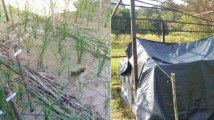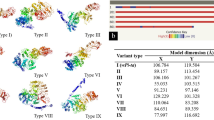Abstract
Magnaporthe grisea, the blast fungus is one of the main pathological threats to finger millet crop worldwide. A systematic search for the blast resistance gene analogs was carried out, using functional molecular markers. Three-fourths of the recognition-dependent disease resistance genes (R-genes) identified in plants encodes nucleotide binding site (NBS) leucine-rich repeat (LRR) proteins. NBS-LRR homologs have only been isolated on a limited scale from Eleusine coracana. Genomic DNA sequences sharing homology with NBS region of resistance gene analogs were isolated and characterized from resistant genotypes of finger millet using PCR based approach with primers designed from conserved regions of NBS domain. Attempts were made to identify molecular markers linked to the resistance gene and to differentiate the resistant bulk from the susceptible bulk. A total of 9 NBS-LRR and 11 EST-SSR markers generated 75.6 and 73.5% polymorphism respectively amongst 73 finger millet genotypes. NBS-5, NBS-9, NBS-3 and EST-SSR-04 markers showed a clear polymorphism which differentiated resistant genotypes from susceptible genotypes. By comparing the banding pattern of different resistant and susceptible genotypes, five DNA amplifications of NBS and EST-SSR primers (NBS-05504, NBS-09711, NBS-07688, NBS-03509 and EST-SSR-04241) were identified as markers for the blast resistance in resistant genotypes. Principal coordinate plot and UPGMA analysis formed similar groups of the genotypes and placed most of the resistant genotypes together showing a high level of genetic relatedness and the susceptible genotypes were placed in different groups on the basis of differential disease score. Our results provided a clue for the cloning of finger millet blast resistance gene analogs which not only facilitate the process of plant breeding but also molecular characterization of blast resistance gene analogs from Eleusine coracana.





Similar content being viewed by others
References
Chethan S, Malleshi NG (2007) Finger millet polyphenols, characterization and their nutraceutical potential. Am J Food Technol 27:282–292
Carine AT, Wang BB, Majesta SO, Shweta D, Zhu HY, Bruce R, Nevin DY, Steven BC (2008) Identification and characterization of nucleotide-binding site-leucine-rich repeat genes in the model plant Medicago truncatula. Plant Physiol 146:5–21
Li CL, Zhang HY (2004) Research advance of resistance gene analogs in plant. Mol Plant Breed 2(6):853–860
Dangl JL, Jones JD (2001) Plant pathogens and integrated defence responses to infection. Nature 411:826–833
Meyers BC, Kozik A, Griego A, Kuang H, Michelmore RW (2003) Genome-wide analysis of NBS-LRR encoding genes in Arabidopsis. Plant Cell 15:809–834
Deyoung BJ, Innes RW (2006) Plant NBS-LRR proteins in pathogen sensing and host defense. Nat Immunol 7:1243–1249
Tan XP, Meyers BC, Kozik A, Marilyn AW, Michele M, Dina AS, Andrew FB, Richard WM (2007) Global expression analysis of nucleotide binding site-leucine rich repeat-encoding and related genes in Arabidopsis. BMC Plant Biol 7:56
Hammond-Kosack KE, Jones JDG (1997) Plant disease resistance genes. Ann Rev Plant Phys 48:575–607
Meyers BC, Dickerman AW, Michelmore RW, Sivaramakrishnan S, Sobral BW, Young ND (1999) Plant disease resistance genes encode members of an ancient and diverse protein family within the nucleotide-binding superfamily. Plant J 20:317–332
Pan Q, Liu YS, Budai-Hadrian O, Sela M, Carmel-Goren L, Zamir D, Fluhr R (2000) Comparative genetics of nucleotide binding site-leucine rich repeat resistance gene homologues in the genomes of two dicotyledons: tomato and Arabidopsis. Genetics 155:309–322
Bai J, Pennill LA, Ning J, Lee SW, Ramalingam J, Webb CA, Zhao B, Sun Q, Nelson JC, Leach JE, Hulbert SH (2002) Diversity in nucleotide binding site-leucine-rich repeat genes in cereals. Genome Res 12:1871–1884
He L, Du C, Covaleda L, Xu Z, Robinson AF, Yu JZ, Kohel RJ, Zhang HB (2004) Cloning, characterization, and evolution of the NBSLRR- encoding resistance gene analogue family in polyploid cotton (Gossypium hirsutum L.). Mol Plant Microbe Interact 17:1234–1241
Cannon SB, Shu H, Baumgarten AM, Spangler R, May G, Cook DR, Young ND (2002) Diversity, distribution, and ancient taxonomic relationships within the TIR and non-TIR NBS-LRR resistance gene subfamilies. J Mol Evol 54:548–562
Walker JE, Saraste M, Runswick MJ, Gay NJ (1982) Distantly related genes in the alpha and beta subunits of ATP synthetase, myosin, kinases and other ATP-requiring enzymes and a common nucleotide-binding fold. EMBO J 1(8):945–951
Saraste M, Sibbad PR, Wittinghofer A (1990) The P-loop-a common motif in ATP- and GTP-binding proteins. Trends Biochem Sci 15(11):430–434
Traut TW (1994) The functions and consensus motifs of nine types of peptide segments that form different types of nucleotide binding-sites. Eur J Biochem 222(1):9–19
Baldi P, Patocchi A, Zini E, Toller C, Velasco R, Komjanc M (2004) Cloning and linkage mapping of resistance gene homologues in apple. Theoret Appl Genetics 109(1):231–239
Lacock L, Van niekerk C, Loots S, Du preez F, Botha AM (2003) Functional and comparative analysis of expressed sequences from Diuraphis noxia infested wheat obtained utilizing the conserved Nucleotide Binding Site. Afr J Biotechnol 2(4):75–81
Totad AS, Fakrudin B, Kuruvinashetti MS (2005) Isolation and characterization of resistance gene analogs (RGAs) from sorghum (Sorghum bicolor L.Moench). Euphytica 143:179–188
He CY, Tian AG, Zhang JS, Zhang ZY, Gai JY, Chen SY (2003) Isolation and characterization of a full-length resistance gene homolog from soybean. Theor Appl Genet 106(5):786–793
Lee SY, Seo JS, Rodriguez-Lanetty M, Lee DH (2003) Comparative analysis of superfamilies of NBSencoding disease resistance gene analogs in cultivated and wild apple species. Mol Gen Genomics 269:101–108
Aarts MGM, Hekkert BTL, Holub EB, Beynon JL, Stiekema WJ, Pereira A (1998) Identification of R-gene homologous DNA fragments genetically linked to disease resistance loci in Arabidopsis thaliana. Mol Plant-Microbe Interact 11(4):251–258
Ilag LL, Yadav RC, Huang N, Ronald PC, Ausubel FM (2000) Isolation and characterization of disease resistance gene homologues from rice cultivar IR64. Gene 255(2):245–255
Mas JG, Van Leeuwen H, Monfort A, De Vicente MC, Puigdome Nech P, Arus P (2001) Cloning and mapping of resistance gene homologues in melon. Plant Sci 161:165–172
Gowda BS, Miller JL, Rubin SS, Sharma DR, Timko MP (2002) Isolation, sequence analysis, and linkage mapping of resistance-gene analogs in cowpea (Vigna unguiculata L. Walp). Euphytica 126(3):365–377
Zhang LP, Khan A, Niño-Liu D, Foolad MR (2002) A molecular linkage map of tomato displaying chromosomal locations of resistance gene analogs based on a Lycopersicon esculentum × Lycopersicon hirsutum cross. Genome 45:133–146
Lopez CE, Acosta IF, Jara C, Pedraza F, Gaitán-Solís E, Gallego G, Beebe S, Tohme J (2003) Identifying resistance gene analogs associated with resistances to different pathogens in common bean. Phytopathology 93:88–95
Lanaud C, Risterucci AM, Pieretti Ingoran JAK, Fargeas D (2004) Characterisation and genetic mapping of resistance and defence gene analogs in cocoa (Theobroma cacao L.). Mol Breed 13(3):211–227
Hinchliffe DJ, Lu Y, Potenza C, Gopalan CS, Cantrell RG, Zhang J (2005) Resistance gene analogue markers are mapped to homeologous chromosomes in cultivated tetraploid cotton. Theor Appl Genet 110(6):1074–1085
Murray MG, Thompson WF (1980) Rapid isolation of high molecular weight plant DNA. Nucleic Acids Res 8:4321–4326
Maniatis T, Sambrook J, Fritsch EF (1989) Molecular cloning, a laboratory manual, 2nd edn. Cold Spring Harbor Laboratory Press, Cold Spring Harbor, New York
Burland TG (2000) DNASTAR’s Lasergene sequence analysis software. Methods Mol Biol 132:71–91
Untergasser A, Nijveen H, Rao X, Bisseling T, Geurts R, Leunissen JAM (2007) Primer3Plus, an enhanced web interface to Primer3. Nucleic Acids Res 35:71–74
Altschul SF, Madden TL, Schaffer AA, Zhang J, Zhang Z, Miller W, Lipman DJ (1997) Gapped BLAST and PSI-BLAST, a new generation of protein database search programs. Nucleic Acids Res 25(17):3389–3402
Jaccard P (1908) Nouvelles recherches sur la distribuition florale. Bull Soc Vaud Sci Nat 44:223–270
Rohlf FJ (2001) NTSYS-pc numerical taxonomy and multivariate analysis system. Version 5.1. Exeter Publishing Ltd, Setauket
Yap IV, Nelson R (1995) WinBoot, a program for performing bootstrap analysis of binary data to determine the confidence limits of UPGMA-based dendrograms. IRRI discussion paper series no. 14. IRRI, Los Banos
Virk PS, Ford-Lloyd BV, Jackson MT, Pooni HS, Clemeno TP, Newbury HJ (1996) Predicting quantitative variation within rice germplasm using molecular markers. Heredity 76:296–304
Pakniyat H et al (1997) AFLP variation in wild barley (Hordeum spontaneum C. Koch) with reference to salt tolerance and associated ecogeography. Genome 40:332–344
Maccaferri M, Sanguineti MC, Noli E, Tuberosa R (2005) Population structure and long-range linkage disequilibrium in a durum wheat elite collection. Mol Breed 15:271–289
Breseghello F, Sorrells ME (2005) Association mapping of kernel size and milling quality in wheat (Triticum aestivum L.) cultivars. Genetics. doi:10.1534/genetics.105.044586
Skøt L et al (2005) An association mapping approach to identify flowering time genes in natural populations of Lolium perenne (L.). Mol Breed 15:233–245
Seo YS, Maria RR, Lee JY, Lee SW, Jeon JS, Pamela R, William JL, Robert LG (2006) A viral resistance gene from common bean functions across plant families and is up-regulated in a non-virus specific manner. Proc Natl Acad Sci USA 103:11856–11861
Robert NGM, David JB, Franc CB, Candice MRS, Paulo CA, Natalia FM, Roberto CT, Manoel TSJ, Georgios JPJ (2008) Analysis of non-TIR NBS-LRR resistance gene analogs in Musa acuminate Colla, isolation, RFLP marker development, and physical mapping. BMC Plant Biol 8:1471–2229
Tameling WI, Elzinga SD, Darmin PS, Vossen JH, Takken FL, Haring MA, Cornelissen BJ (2002) The tomato R gene products I-2 a MI-1 are functional ATP binding proteins with ATPase activity. Plant Cell 14:2929–2939
Leister RT, Katagiri F (2000) A resistance gene product of the nucleotide binding site-leucine rich repeats class can form a complex with bacterial avirulence proteins in vivo. Plant J 22:345–354
Rairdan GJ, Moffett P (2006) Distinct domains in the ARC region of the potato resistance protein Rx mediate LRR binding and inhibition of activation. Plant Cell 18:2082–2093
Acknowledgments
The authors wish to acknowledge the Department of Biotechnology, Govt. of India for providing financial support in the form of Programme Mode Support for research and development in Agricultural Biotechnology at G.B. Pant University of Agriculture and Technology, Pantnagar (Grant No. BT/PR7849/AGR/02/374/2006). The first author was supported by fellowship from DBT, India during the project programme. The authors thank the All India Co-ordinated Small Millets Improvement Project, ICAR, UAS, GKVK, Bangalore and Hill Campus, Ranichauri G. B. Pant University of Agriculture and Technology for providing the seed samples and passport data of the germplasm analyzed in present study. We are highly thankful to Dr. T. Mohapatra for his kind academic inputs in data analysis and interpretation of data.
Author information
Authors and Affiliations
Corresponding author
Rights and permissions
About this article
Cite this article
Panwar, P., Jha, A.K., Pandey, P.K. et al. Functional markers based molecular characterization and cloning of resistance gene analogs encoding NBS-LRR disease resistance proteins in finger millet (Eleusine coracana) . Mol Biol Rep 38, 3427–3436 (2011). https://doi.org/10.1007/s11033-010-0452-0
Received:
Accepted:
Published:
Issue Date:
DOI: https://doi.org/10.1007/s11033-010-0452-0




